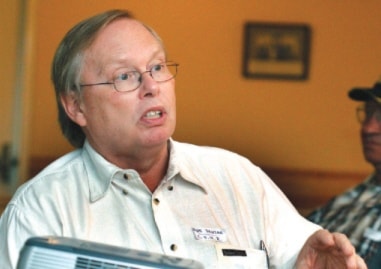One of the things driving the Alberta economy, and some argue, the Canadian economy is, oilfield activity. Much of that activity relates to hydraulic fracturing, also known as fracking.
Understanding the industry has become somewhat of a contentious issue with advocates and opponents wanting to defenestrate the other out the door.
The Calumet Synergy Association (CSA) and the Canadian Society of Unconventional Resources (CSUR) hopes to bridge the gap between fact and fiction. CSA member Larry Walton wants Albertans to have an understanding of how it all works.
“Our purpose is to communicate and educate, we have no agenda. Just trying to to get landowners and industry together. And it’s worked,” stated Walton.
CSUR president Mike Dawson was invited recently by CSA to explain fracking at Schultz Hall to curious attendees.
CSUR has 135 member companies, mostly in the industry, but also some education and government institutions as well.
“My goal is to explain significant technical topics,” Dawson stated.
He began by presenting a “Coles Notes version” of hydraulic fracturing to attendees.
The oil and gas industries in both Canada and the United States have undergone large changes to their process of extracting resources, which has become more difficult.
“That’s what I classify as the low-hanging fruit, those easy-to-explore reservoirs where we drill for them and we’ve gotten lots of production,” he said.
The majority of wells 70 per cent drilled in Alberta are now horizontal wells rather than vertical, which are able to recover a larger amount of product, explained Dawson.
Dawson said the benefit of a horizontal well is the access to large reservoirs of unconventional resources; new drilling technology has given companies greater access to product.
These reservoirs are actually different types of rock that hold the desired hydrocarbons; shale, limestone, and volcanic pumice are among some of the rock formations hydraulic fracturing works against.
Each rock has a certain amount of permeability — pores, which gas and liquid can flow through — with shale having the lowest, thus requiring more fracking than volcanic pumice, which is quite porous in comparison.
Horizontal wells incorporate a process called multi-stage fracturing. The well goes along the length of a reservoir, sometimes 3,800 metres in length but could be 60 metres thick. Drilling companies generally use water and sand called slick water, to place into a fractured rock reservoir, but water is not necessarily the only way. “It can be a variety of fluids as…long as it can transmit that pressure.”
The main reason companies use water, particularly in shale wells, is because “it’s cheap and readily available.”
Water use for a frack can be one to three million litres, explained Dawson, with 99.51 per cent comprising water and sand. The other .49 per cent — approximately 4,900 litres per one million litres of water — has a variety of chemicals to assist with the process.
Most of the proppant stays in the ground. “When you’re using slick water fracking, we’re only really getting in the order of 40 to 50 per cent of the fluid back to the well bore after a reasonable length of time.”
Water that does return will be recycled as much as possible and the rest will be disposed of through a government regulated disposal site.
This slick water, or proppant, keeps the sand in the cracks, which allows hydrocarbons to have a place to escape. The amount of water used can be quite large for some operations, especially if there are more fracking stages along the reservoir.
“What’s different in these slick water fractures is we’re using much bigger volumes. Those much bigger volumes are over say 10 or 15 stages of fracks that are in the horizontal way,” he explained.
He suggests the industry needs to consider how to reduce the volume of water used.
There is no opportunity for chemicals to enter the groundwater as they are usually much lower in the subsurface, and wells require layers of protection when they are closer to the surface. Three layers of steel pipe surround wells and concrete is poured around the outside of the pipes to ensure nothing seeps into the groundwater wells.
There have been cases of contamination to groundwater, which Dawson attributed to poor well construction. He said cement should cure for eight hours before drilling begins.
“There is no excuse for these types of actions to occur,” stated Dawson.
Industry standards are clear on proper well construction, he offered.
Dawson saw some downsides to using water for fracking; finding enough water to conduct a frack, what do with the water when it returns, especially since it can’t be put back into the ground. Other downsides could be an increase in road traffic
Carla Peterson was an attendee of the presentation, she felt other means of extracting resources should be used. “I think they should find something else to use besides water.”
For Brenda Knight it is a balance of industry and stewardship of water resources.
“Personally I’m fairly comfortable with the regulations that are in place with the oil and gas industry,” she said.
Attendees were treated with a dinner and informal discussion after the session.
